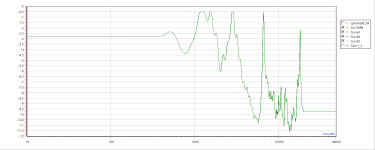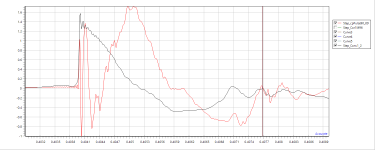1. In what ways can DSP make an existing speaker better?
Sorry, I come late to the party.
This very question points to one of THE most rewarding applications for DSP: The use of DSP to tame the typically quite wild step response of passive multiway speakers. Decently doing so, you will get a near-perfect ideal step response.
Most rewarding is to start from a well renown design, maybe from a well built vintage passive speaker, such as a Yamaha NS1000 and the like. In my use case, I have a pair of Cabasse Sampan 311 built in the early 1980's which overall perform quite pleasantly. Adding a simple DSP filter stage stage to linearize theirs phase behavior makes theirs step response simply look gorgeous. And all this beauty will set you back only by some 50$ ... 100$ for a raspberry py and maybe an IO-board.
The filter of the following example was set up also to have an effect on the amplitude characteristic. The filter itself is rather rough in this terms, but very well shows the effect on the phase. Furthermore, the amplitude graphs show all room reflections. In the phase plots, the first reflections artefacts are marked at about 3.5ms after the impulse onset.
Red: Original passive 3-Way
Black: Original x DSP filtering
Green: DSP filter (modifying both phase and amplitude behavior)
Attachments
I see you also use Acourate. Good choice!
Yes. Acourate. What else? (Ref. Clooney / Nespresso)
I first read about Acourate (in 2008 ?) on Angelo Farina's Aurora Webpage:
" ... Acourate by Ulrich Brüggemann - impulse response measurement and computation of inverse FIR filters, also including AQT method. A new project, when finished it will be a very powerful and easy tool for digital equalization of sound systems. ..."
And I ordered my copy right away. And since then in all these 15 years, Acourate never got finished. Fortunately. Instead, it steadily got more and more powerful and also easy to use. Without Acourate, I never would have been able to set up such interesting projects as e.g. the Horbach-Keele dipoles. And, last not least and for the thead's title sake, I always got more than the required fidelity of DSP crossover at high frequency 🙂
I met Uli last year at the European Triode Festival, where he offered to room correct my ESLs on the spot.
Impressive. Worth the price.
It did more for my sound than anything I did in a decade before.
I'm exporting his filters to JRiver and use that as my player.
Jan
Impressive. Worth the price.
It did more for my sound than anything I did in a decade before.
I'm exporting his filters to JRiver and use that as my player.
Jan
I was late to the party too.
Speaking of which, a great primer re: DSP is this book.

By our very own @mitchba
Better late than never.
Speaking of which, a great primer re: DSP is this book.
By our very own @mitchba
Better late than never.
Excellent book, which takes you through the whole process.
He uses mostly Acourate but also REW, but the process is basically the same with other software.
BTW The book is also available as eBook for those cash strapped.
Jan
He uses mostly Acourate but also REW, but the process is basically the same with other software.
BTW The book is also available as eBook for those cash strapped.
Jan
What DSP you use? 0.5ms is very shocking to me. Pretty much all the DSPs I tried on Windows has more than 20ms latency.Ouch! 20ms of buffering... this is slow. My dsp have something like 0,5ms ( don't remember exactly) from in to out at 96khz. My computer with Rme sound card might be in the 1,5ms range for same condition ( under windows). I'm virtually unlimited about IIR treatments in both case and this number are given with those engaged.
I'm not thinking about group delay, was talking about FIR where the lower you xover and the steepest the slope the more you need latency of treatments: in the Lake, for 48db/octave FIR under 100hz you need 25ms latency ( or 50ms i can't remember at the moment, it's not specified in Tap number but in slope steepness in the gui).
Mark100,
At least they decide to implement latency compensation! It's great for video which was painful to use with FIR in previous JRIVER version. It could even make real time monitoring of video+audio possible ( with a global delay but not different that how 'live' materials are broadcasted for some years anyway!).
^ Hi,
Dolby Lake dlp4d12.
I bet you don't use pro gear: 20ms latency is a no-no when monitoring musician playing real time.
IIrc a Protools hd3 had something like 1ms max native system latency between input/output ( not taking into account the treatments applied of course).
The average max latency allowed in pro gear is 5ms as (average) musicians are bothered past that limit. One of the reason i have two presets availlable in the Lake, one with FIR i use for playback only ( 25ms total latency including filters) and a IIR i use for monitoring of realtime events (iow musicians while tracking- something along 2ms at 96khz iirc).
Dolby Lake dlp4d12.
I bet you don't use pro gear: 20ms latency is a no-no when monitoring musician playing real time.
IIrc a Protools hd3 had something like 1ms max native system latency between input/output ( not taking into account the treatments applied of course).
The average max latency allowed in pro gear is 5ms as (average) musicians are bothered past that limit. One of the reason i have two presets availlable in the Lake, one with FIR i use for playback only ( 25ms total latency including filters) and a IIR i use for monitoring of realtime events (iow musicians while tracking- something along 2ms at 96khz iirc).
- Home
- Loudspeakers
- Multi-Way
- Fidelity of DSP crossover at high frequencies



